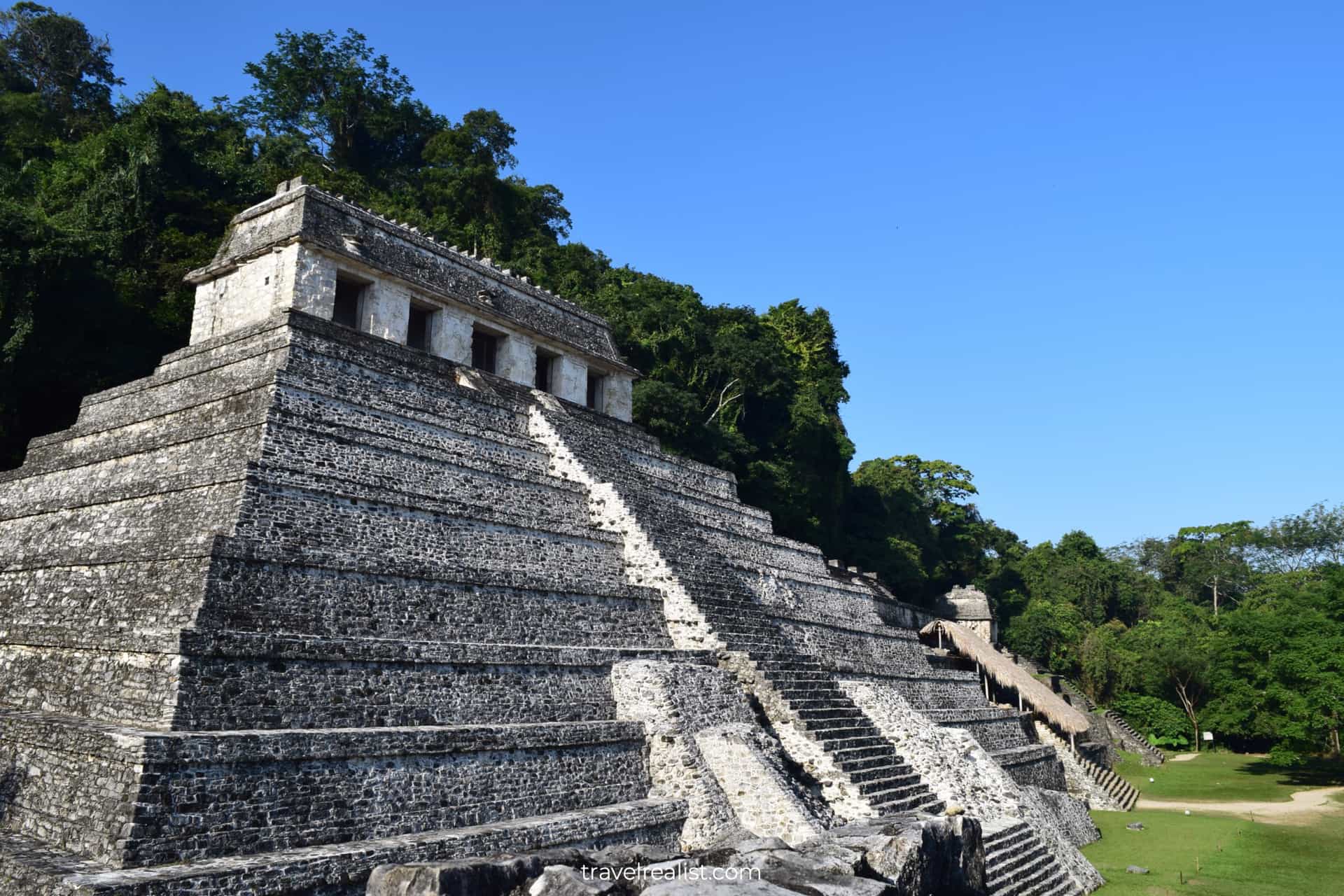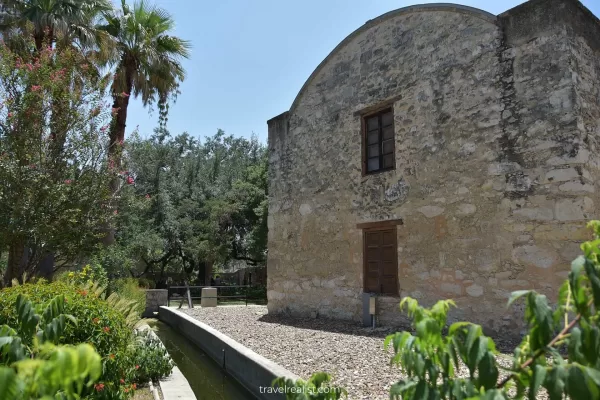Ithaca Waterfalls: Explore Finger Lakes in Winter
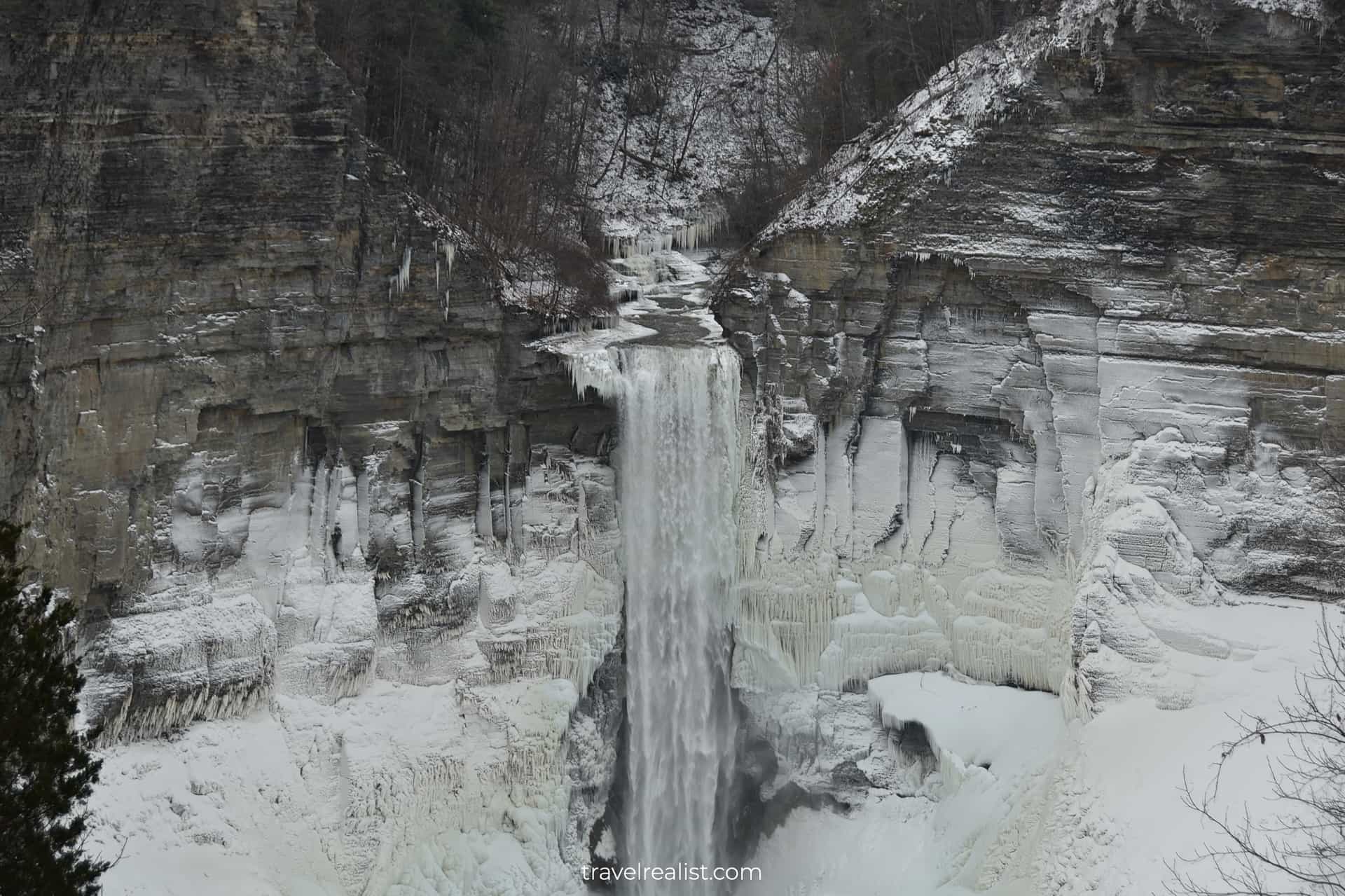
This realistic Ithaca Waterfalls Guide helps you plan your next winter adventure in the Finger Lakes region.
Ithaca, New York is the largest town in Finger Lakes. This college town is home to Cornell University and an astonishing number of waterfalls.
This post includes affiliate links that will earn us commission if you make a purchase via these links.
Sights & Places of Interest
Ithaca is a capital of the Finger Lakes region. There are 150 waterfalls within or just outside of the city limits. This is an incredible count for New York and the United States.
You could expect to find a similar number of waterfalls in Iceland but not in Upstate New York. It makes Ithaca waterfalls even more spectacular.
This Ithaca Waterfalls Guide describes a winter visit to Ithaca, Triphammer, Rocky, Horseshoe, and Taughannock Falls.
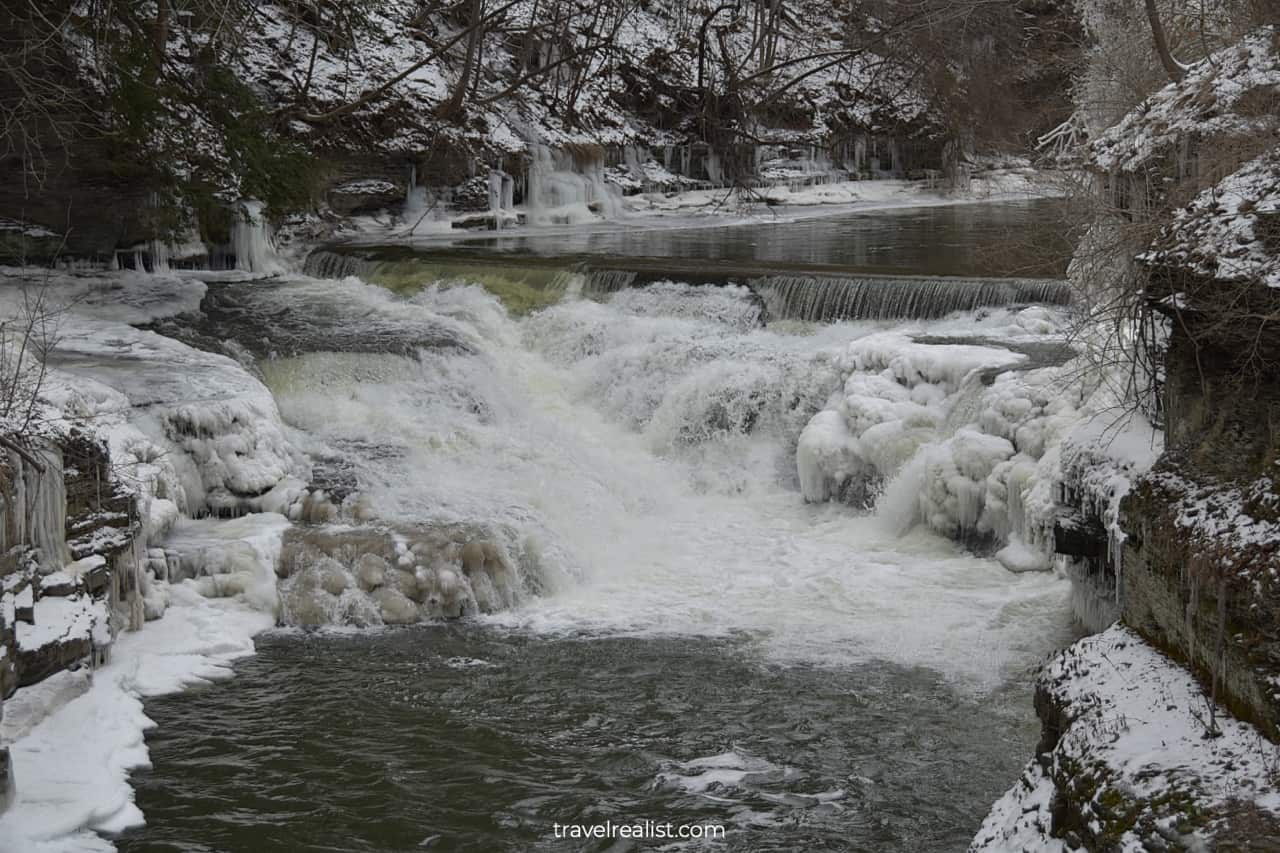
1. Ithaca Falls
Ithaca Falls is a great first waterfall for your visit to Ithaca and Finger Lakes. The parking lot is just a mile (1.6 km) north of the center of the town.
But location is not the only reason to start your visit with Ithaca Falls. These falls are also the most powerful waterfall of the region.
The next few sections of this Ithaca Waterfalls Guide walk you through a visit to Ithaca Falls.
1.1. Trail
You would need to hike to see Ithaca Falls. The hike is on a flat 0.2-mi (0.3-km) out-and-back trail. You could complete it in less than 5 minutes during most of the year.
But a winter visit to Ithaca Falls is quite different. You might have to hike on a snowy path. The mist from the falls might cause the banks of Fall Creek to freeze. In this case, snow might be hiding a layer of ice.
You would be taking a risk hiking to the falls viewpoint even if you have sturdy hiking shoes. This short trail could take you almost 30 minutes to complete.
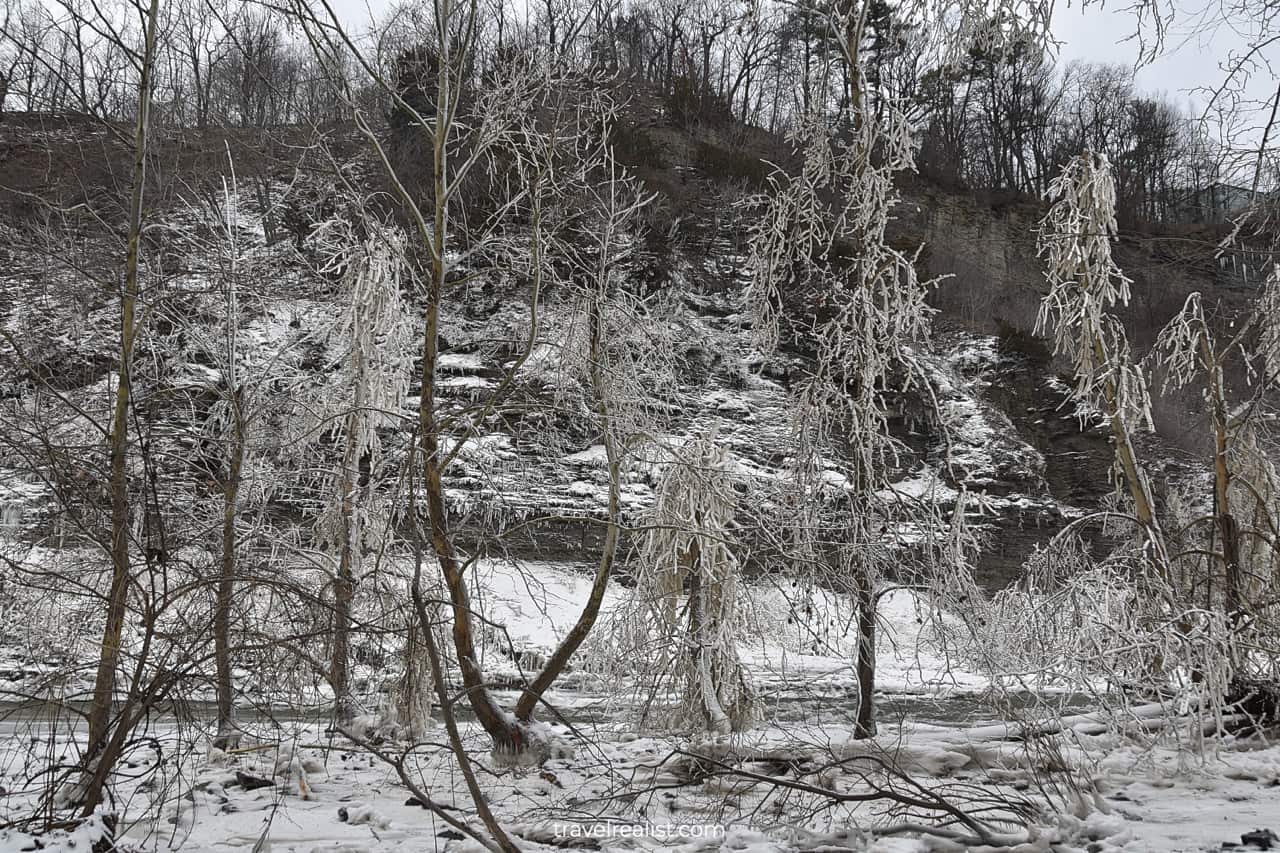
Take it easy as you navigate between the icy and snowy trail sections. You should focus your attention on picking the safest path.
You could admire frozen branches of the trees when you take a break. The closer a tree is to the waterfall, the more likely it is to be frozen. It would look as if the branches are made of ice.
You could look for the ruins of the 19th century mills on the south bank of Fall Creek. You should also park at a more spacious upper lot if the ruins are of great interest to you.
The ledges look a bit similar to Starved Rock State Park near Chicago, Illinois. But you should not approach them due to the chemical contamination of this area.
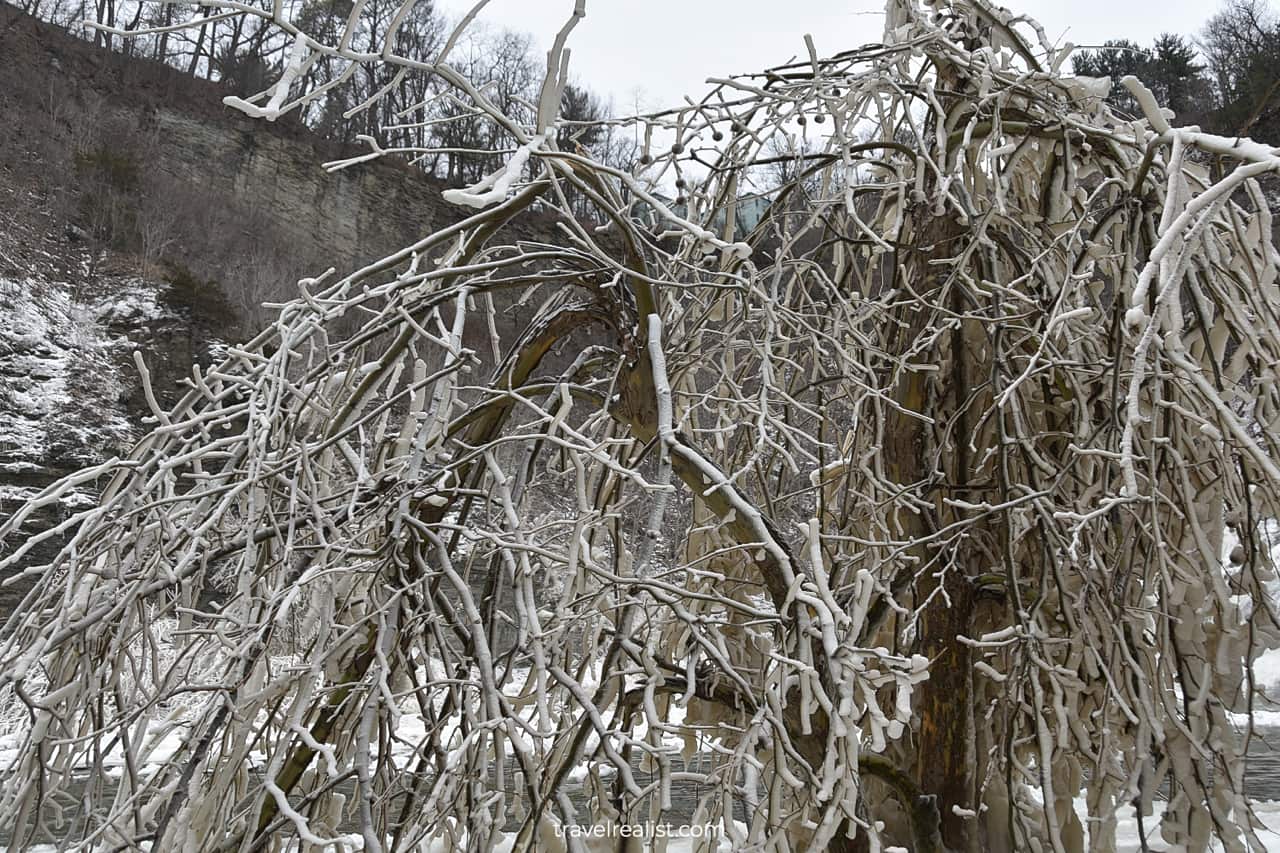
1.2. Waterfall
You will get a clear view of the waterfall around 0.1 miles (0.2 km) into the trail. There will be no trees or ledges in your view.
Enjoy these 150-ft (46-m) high and 175-ft (53-m) wide waterfall. While Ithaca Falls is no Niagara Falls, you will feel the mist coming from this waterfall.
Unless you wear a waterproof jacket, this mist could pose a challenge when visiting in the winter. You would not want to race back to your car on an icy trail.
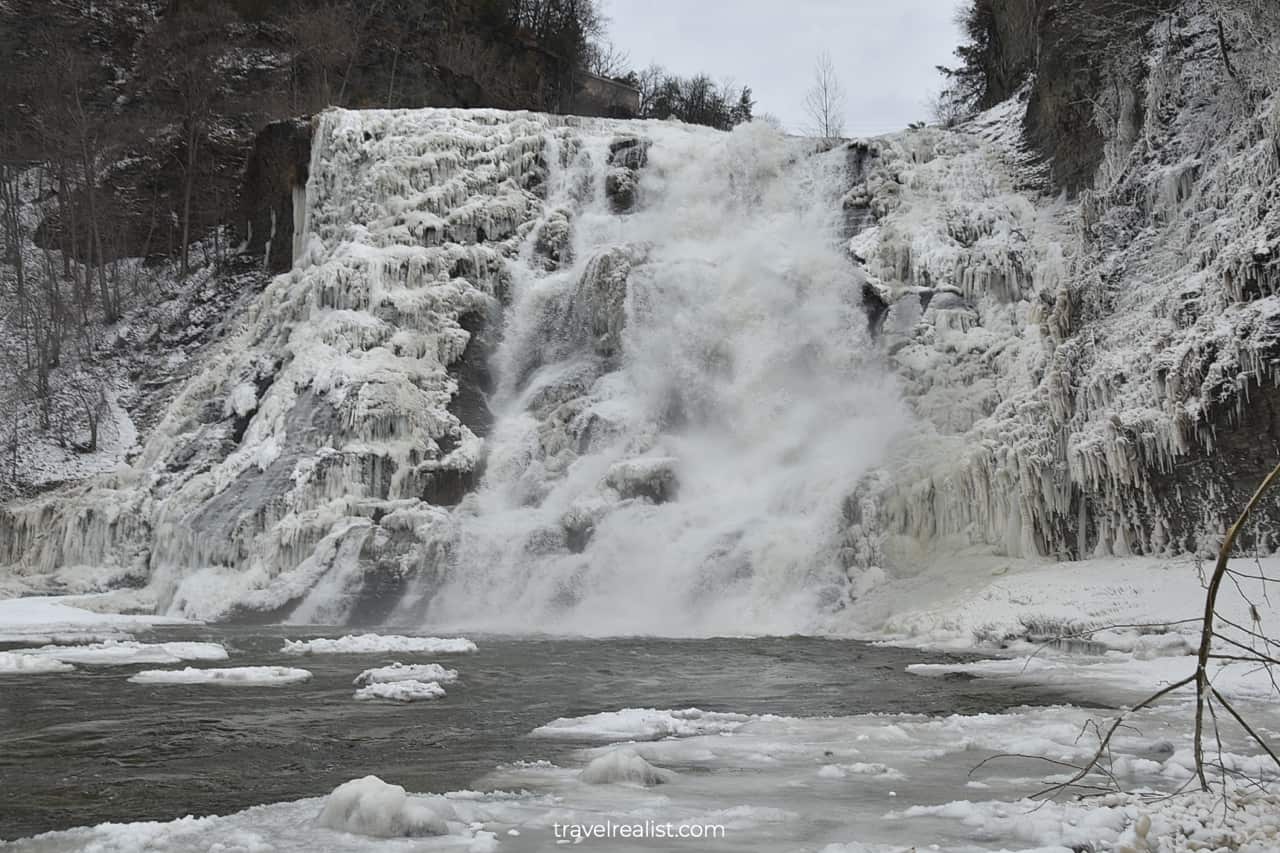
2. Waterfalls on Cornell University Campus
You would need to follow Fall Creek upstream to see other falls within Ithaca city limits. There is no trail or path that connects Ithaca Falls with the waterfalls upstream.
As a result, it is best to get back to your car and drive to the Toboggan Lodge Parking Lot. This lot is in the middle of Cornell University campus.
This private university is part of the Ivy League. Its campus dates back to 1865. As a result, it is the youngest of all Ivy League Schools. Harvard University is nearly 230 years older.
The next few sections of this Ithaca Waterfalls Guide cover a walk along Fall Creek on Cornell University campus.
2.1. Triphammer Falls & Beebe Lake
You could see the next waterfall by taking another 0.1-mi (0.2-km) path. Triphammer Falls are the main falls on campus. They are right next to the Martin Y. Tang Welcome Center and Alumni House.
Triphammer Falls are nowhere near as tall as Ithaca Falls. These cascading falls reach the height of 55 ft (17 m). But they are still beautiful thanks to their cascading nature.
You could enjoy the views of Triphammer Falls from the Beebe Dam Bridge. This dam not only led to the development of Beebe Lake. It also had an impact on the falls, altering their flow.
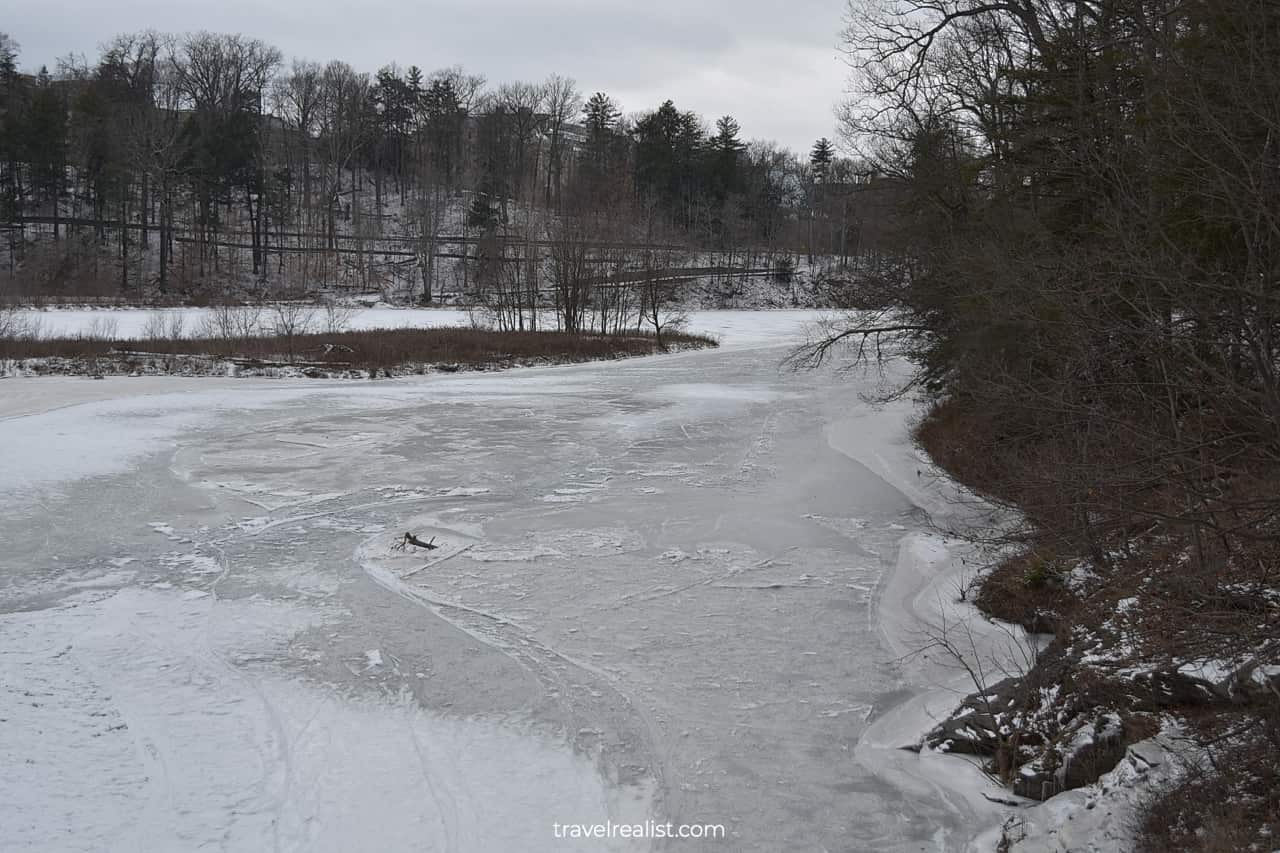
2.2. Werly island
Two other named waterfalls on campus are downstream. But there is no easy path to see Horseshoe Falls and Rocky Falls. It might be a good idea to take a walk around Beebe Lake first.
There is a paved 0.9-mi (1.5-km) loop path. You could take this path in any direction. But most of the sights are on the northern shore of the lake.
Keep in mind that the path and the stairs next to the lake often close in the winter. In this case, you would have to take a longer walk on Forest Home Drive and Credit Farm Drive.
You are certain to see Werly Island from the loop path or the streets. This small island is perfect for bird watching during most of the year. But you might not find this stop as exciting in the winter.
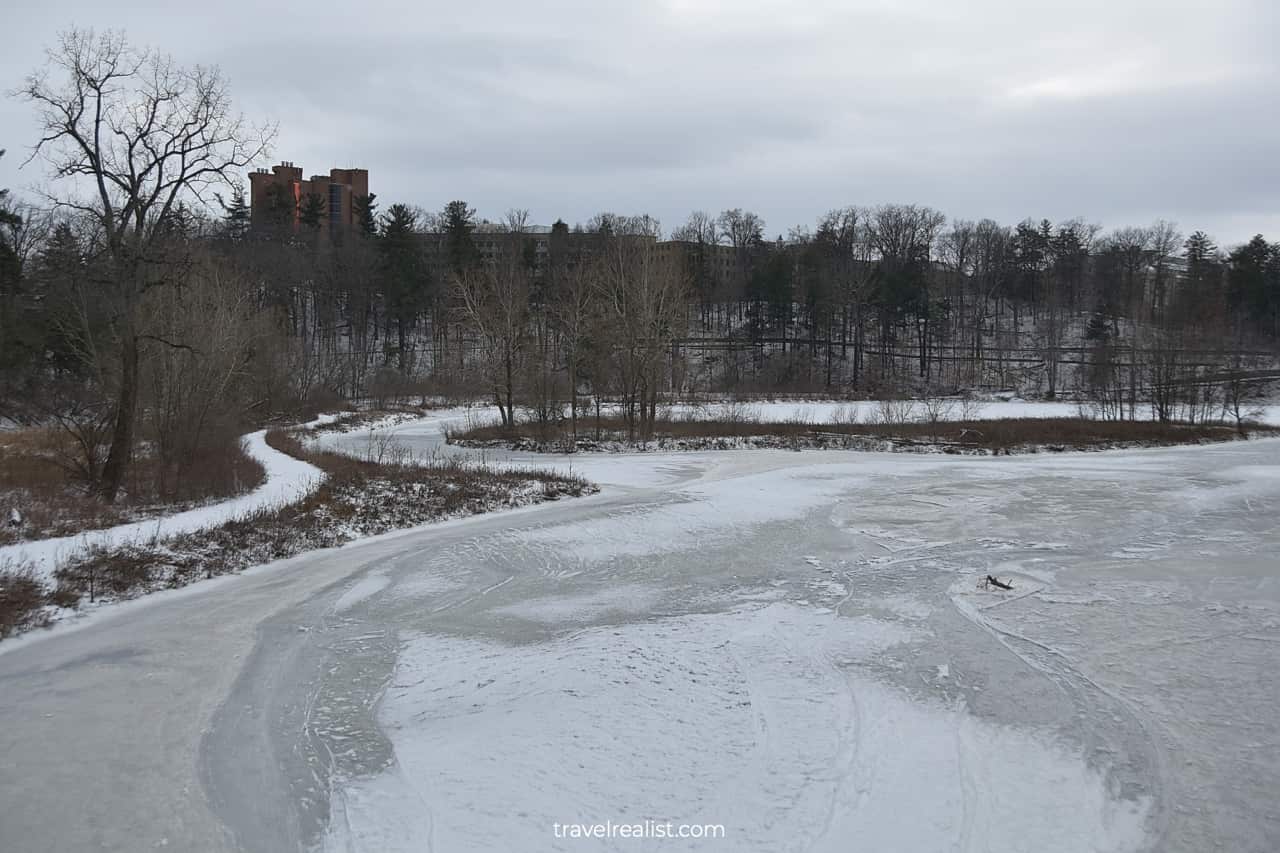
2.3. Sackett Foot Bridge
There is one attraction on the Beebe Lake loop walk that will grab your attention year round. The stone Sackett Foot Bridge is at the head of the lake.
This bridge is one of the most photographed places at Cornell University. It is stunning during any season and time of the day.
Yet, fall is the best time to visit the Sackett Foot Bridge. Visitors and locals try to capture the reflections of the bridge and the fall colors in the lake.
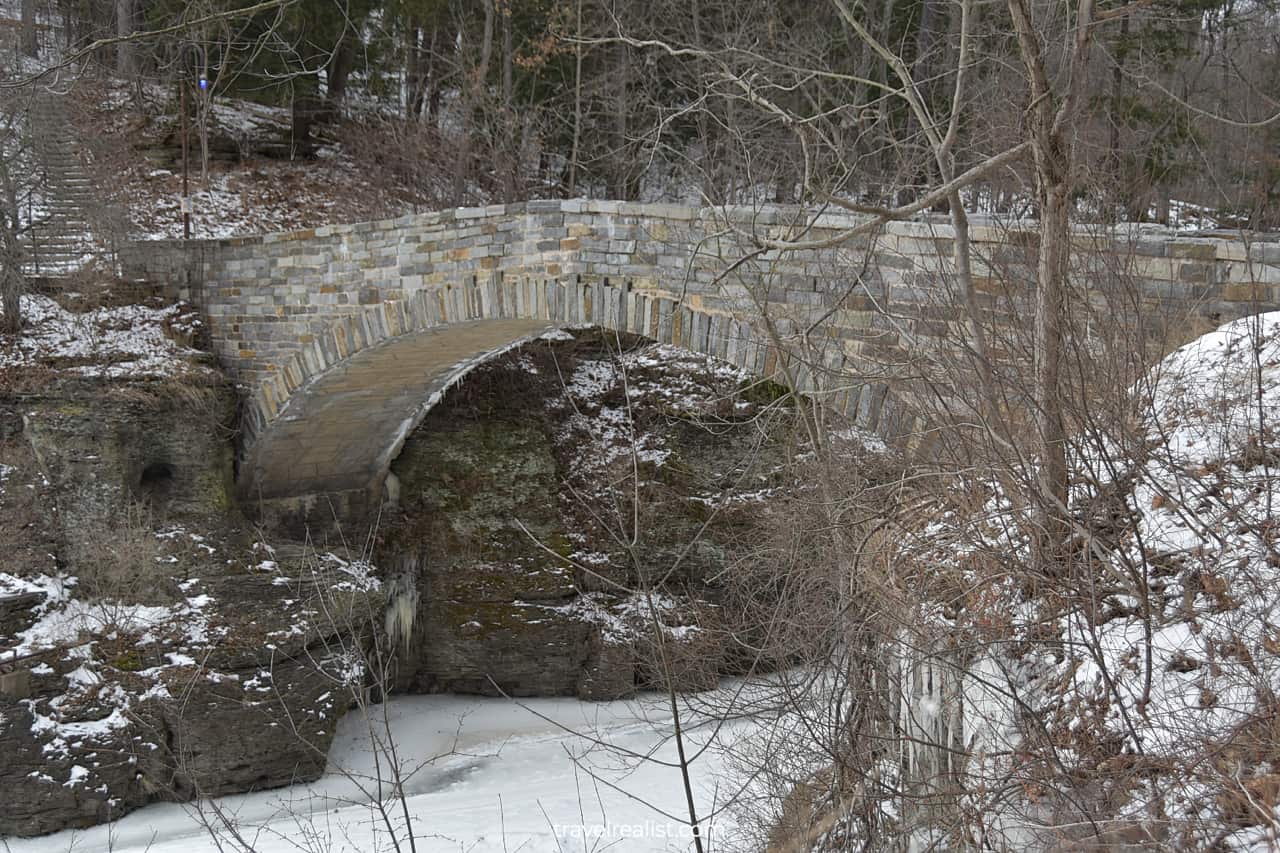
You should still head to the bridge if you visit the campus in the winter. Frozen Fall Creek and Beebe Lake will not give any reflections. But icicles create a different look for this iconic bridge.
Ice on the path is the only downside to a visit. The road signs are right: bridges ice before roads. Be extra careful when crossing the Sackett Foot Bridge during the cold winter months.
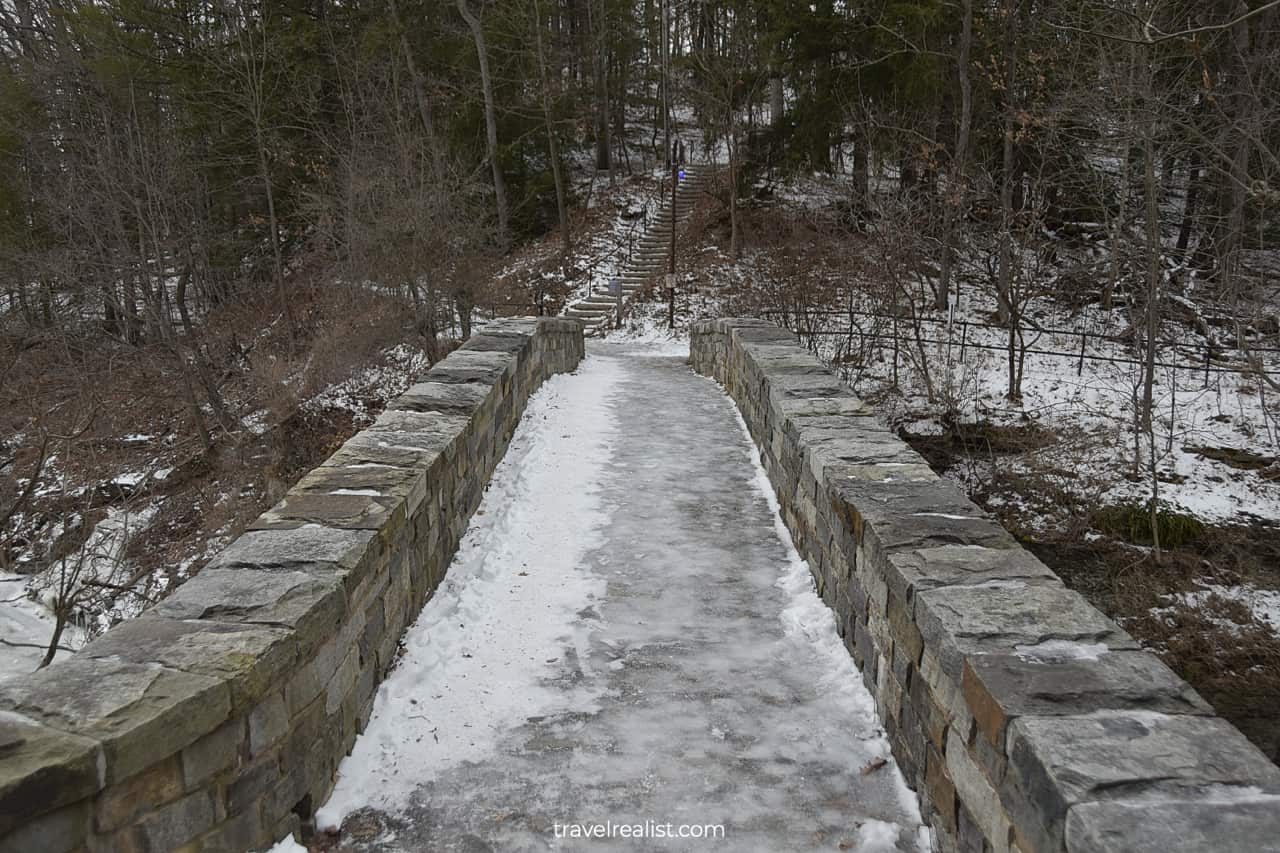
2.4. Fall Creek
Fall Creek narrows after Beebe Lake. It forms a narrow gorge with steep drops on both sides. It starts to look more like a creek in Rocky Mountain.
You might want to explore this gorge further. A narrower gorge means a stronger current. In turn, this could mean another waterfall.
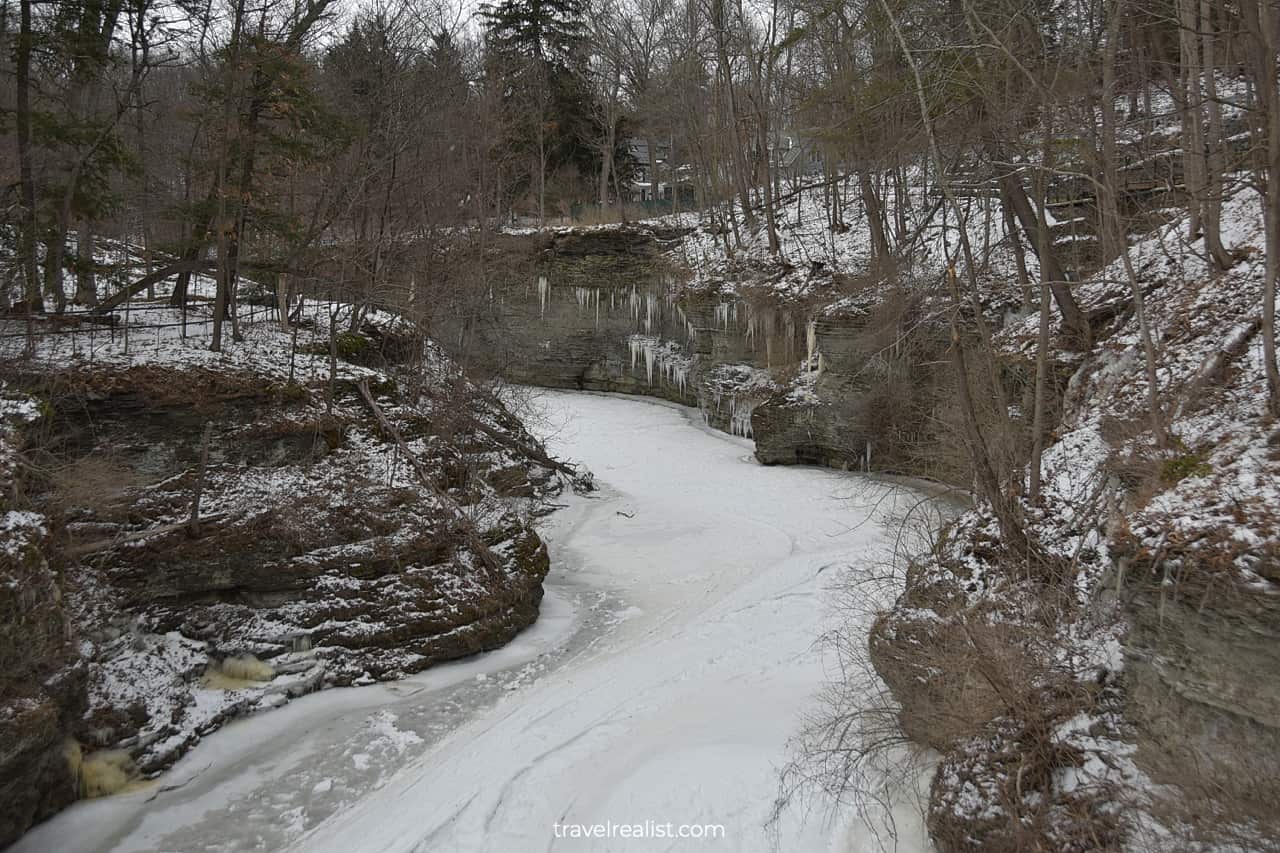
In this case, you should take a short side trail. Another loop path brings you past the Sackett Foot Bridge into the Gorge. You will follow the north rim of Fall Creek Gorge on a dirt path. This trail is quite flat.
Icicles and frozen storm drains will be the main attractions for the first few hundred feet (meters). Pay extra attention to your steps since the path could have lots of ice.
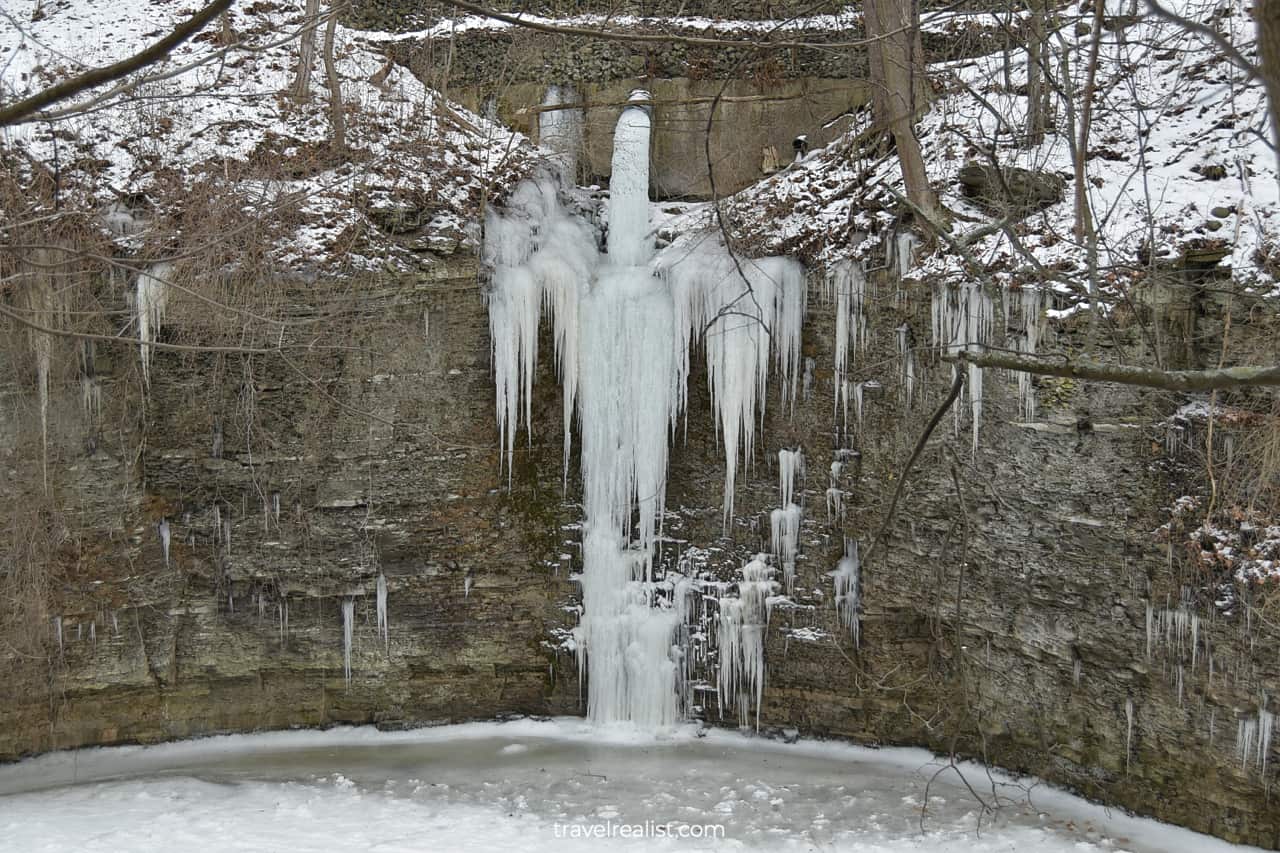
You will arrive at a no name waterfall viewpoint right before the trail starts to climb. The trail goes to the Fuertes Observatory.
This waterfall is a human made cascade. It is not tall or powerful enough to warrant a name. Still, you could enjoy a powerful current with lots of foam.
A few parts will have ice. But the creek will be flowing underneath the ice cover. It is a good place to admire the power of nature for a few minutes.
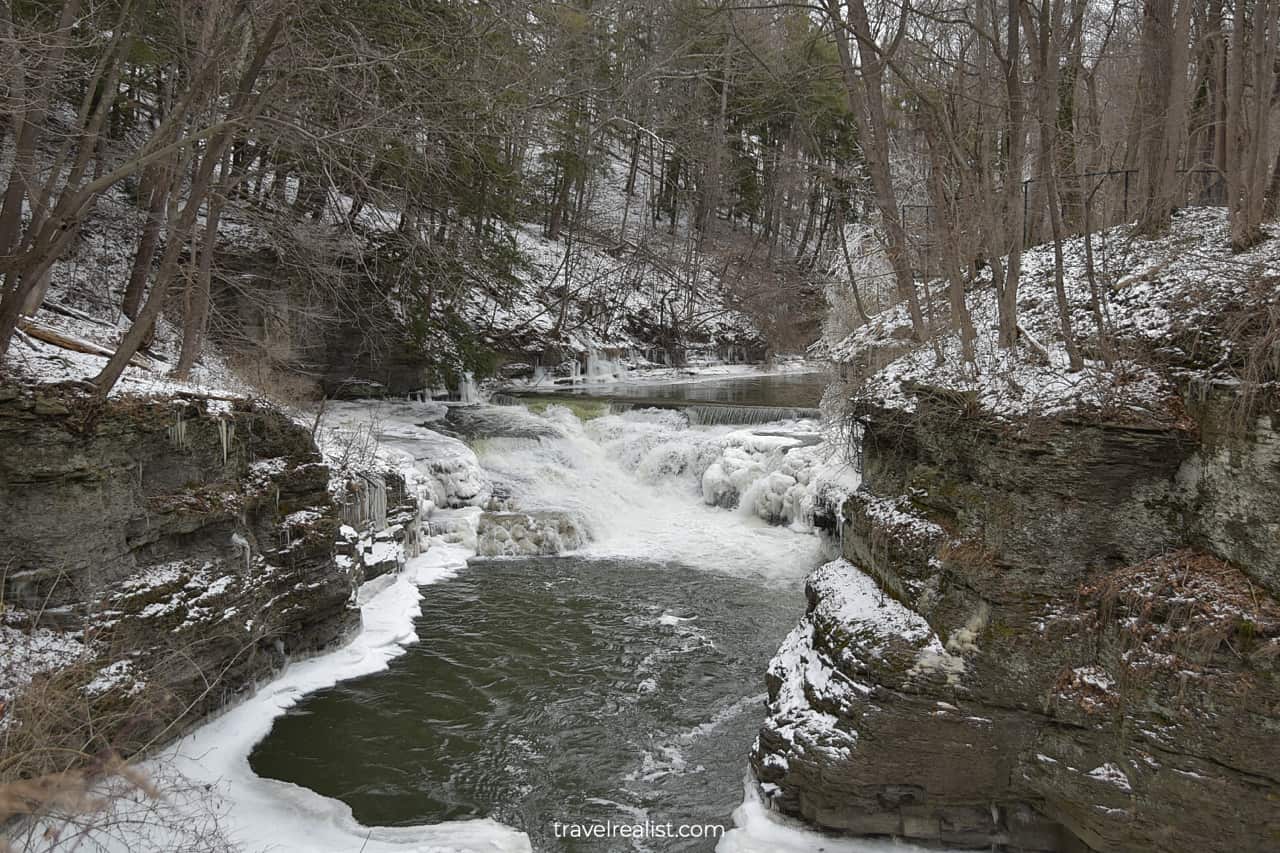
2.5. Rocky Falls & Horseshoe Falls
You should try to visit Rocky Falls and Horseshoe Falls after a walk around Beebe Lake. These waterfalls are close to one another. Yet, you might find it difficult to get a look of them.
You could only see Rocky Falls from the Fall Creek Suspension Bridge. The protective metal netting on both sides of the bridge will be in the view.
But the netting is only one of the issues with Rocky Falls. This 25-ft cascade is flowing at an angle. A steep gorge wall hides most of it. A historic hydroelectric plant hides the rest.
Horseshoe or Forest Falls are right below the Fall Creek Suspension Bridge. As a result, you will not see most of these falls from above.
But you could take the stairs down to the creek level. This 0.4-mi (0.6-km) trail drops 174 ft (53 m) in elevation. The trail brings you to a falls viewpoint below the suspension bridge.
A visit to the Horseshoe Falls might not be the best idea in the winter. No one looks after this path during the winter season. There will be snow and ice on this trail.
You will be hiking down the ice covered stairs. It could take you an hour to reach the lower viewpoint. You might be better off using this time to chase another Ithaca waterfall.
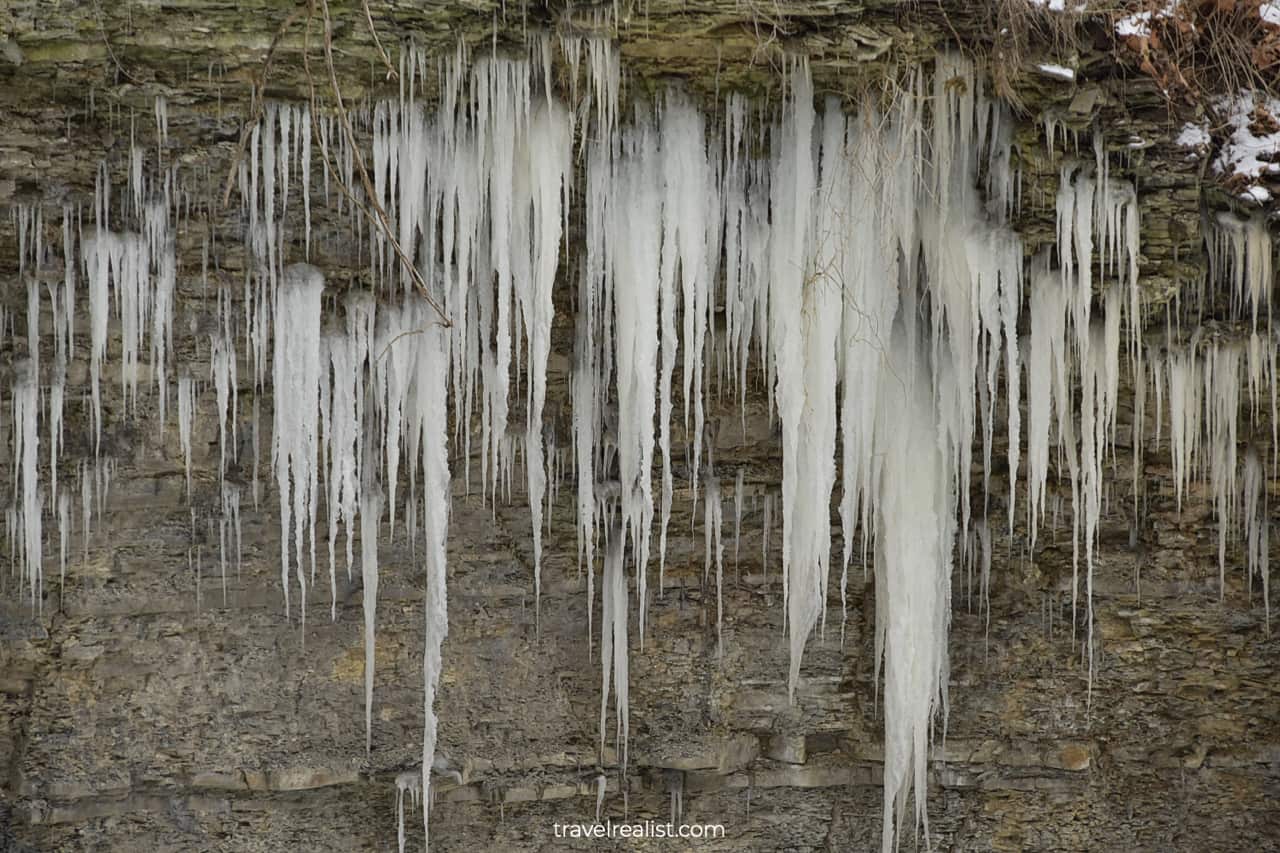
3. Taughannock Falls
Any exploration of the Ithaca waterfalls will not be complete without a visit to Taughannock Falls. This 215-ft (66-m) tall waterfall is the tallest in the region.
It could rival a handful of falls in Iceland in beauty. So, it is a good idea to take a trip to see this waterfall first hand.
You would need to drive to see Taughannock Falls. This waterfall is 11 miles (18 km) north of the city. It is on Taughannock Creek that flows into Cayuga Lake.
The creek partially freezes in the winter. Yet, the waterfall continues falling down unless the temperatures hit record lows. You should be able to enjoy Taughannock Falls even at the height of winter.
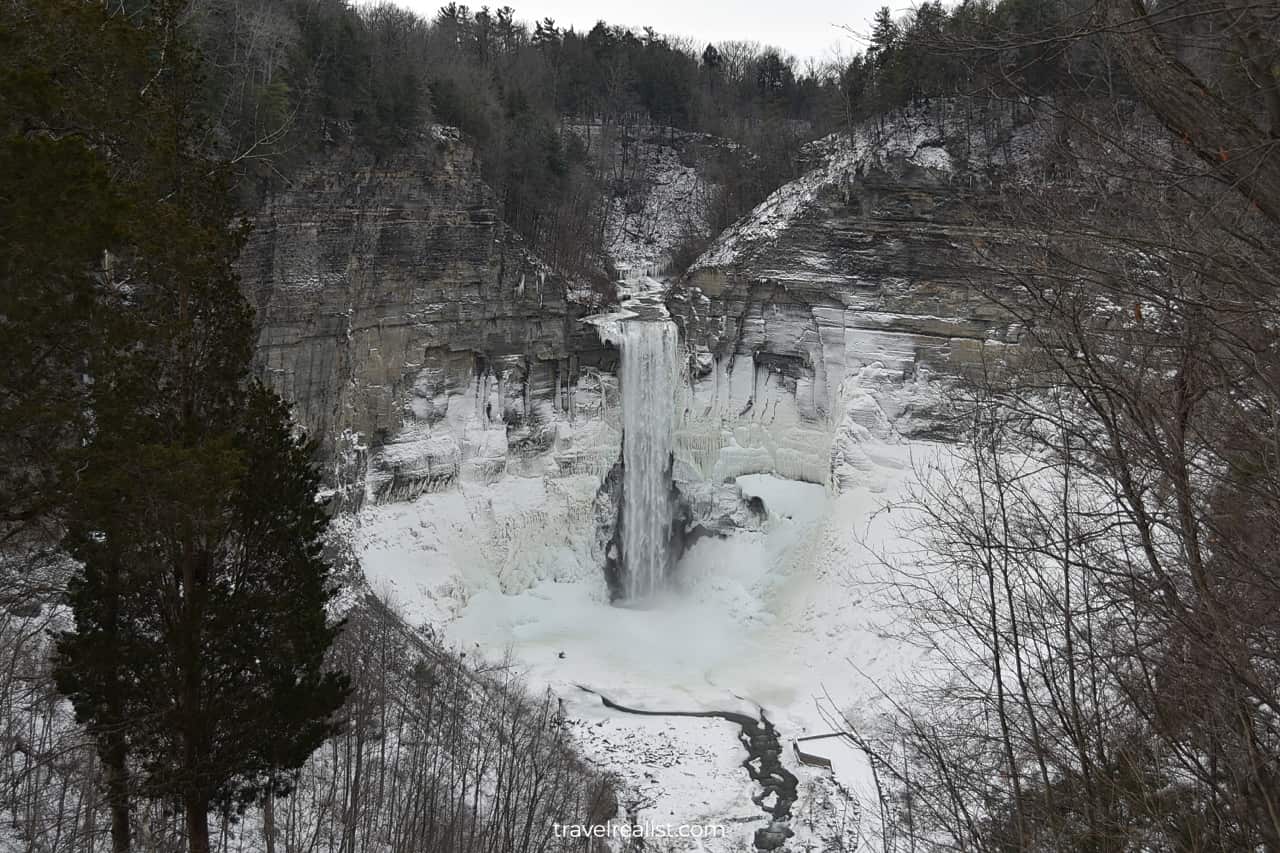
A viewpoint is the easiest way to see this waterfall. All you need to do is pull over and get out of your car. The waterfall will be on full display.
There is a trail that brings you to Taughannock Creek Gorge. You will be able to see the lower observation deck from the viewpoint.
The trail into the gorge and all other trails in the park close with the first snowfall. They remain closed until snowmelt. It usually takes place around late March or early April.
This way, state park rangers reduce your risk of injury. But this rule has trade-offs. You cannot enjoy the full beauty of Taughannock Falls if you visit the park in the winter.
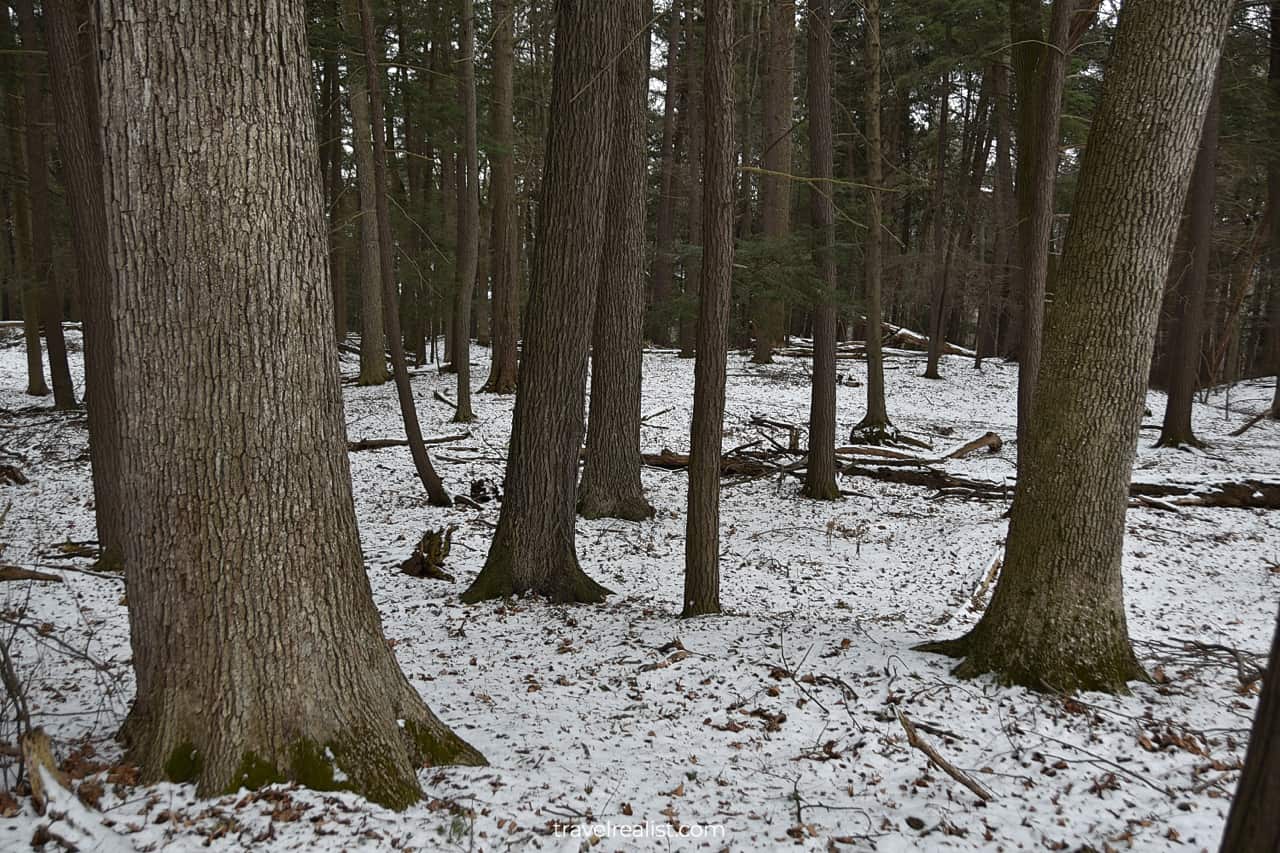
Continue with this Ithaca Waterfalls Guide. You will learn more about ways to get to the sights, entrance requirements, and places to stay.
Getting to Ithaca Waterfalls
Ithaca is a town in the Finger Lakes region of Upstate New York. There are eleven Finger Lakes in this region. Ithaca is at the southern shore of Cayuga Lake, the longest of the lakes.
The town is about equally far from Buffalo and Albany. It is also just out of the way of four major Interstate Highways (I-81, I-86, I-90, and I-390).
As a result, a visit to Ithaca and its nearby town of Watkins Glen could add hours to your journey. But the beauty of Ithaca Waterfalls and the Finger Lakes region makes this drive worth it.
It is easiest to visit Ithaca from other cities in Upstate New York and Pennsylvania. Syracuse is just an hour away from Ithaca. Its airport (SYR) is also the main gateway to Finger Lakes.
Rochester (ROC) and Wilkes-Barre Scranton (AVP) are other options for out-of-state visitors. They are about 2 hours northwest and southeast of Ithaca.
Buffalo Niagara (BUF) and Albany (ALB) are around 3 hours away. None of these airports are major hubs. Unless you score a deal on a low cost carrier, you are looking at longer drives from the bigger cities.
Newark Liberty (EWR) is 3.5 hours away. Philadelphia (PHL) and John F. Kennedy (JFK) are about 4 hours south. A drive from Boston (BOS) or Pittsburg (PIT) takes over 5 hours.
A rental car is the fastest and often cheapest way to reach Ithaca. You will appreciate the convenience it offers to see the waterfalls around the city. But a car is not the only way to get to Ithaca.
There is a bus route that connects Ithaca with Port Authority Bus Terminal in NYC. A ShortLine Chenago bus takes between 4 and 4.5 hours. This bus ride costs $34.99+ per adult each way.
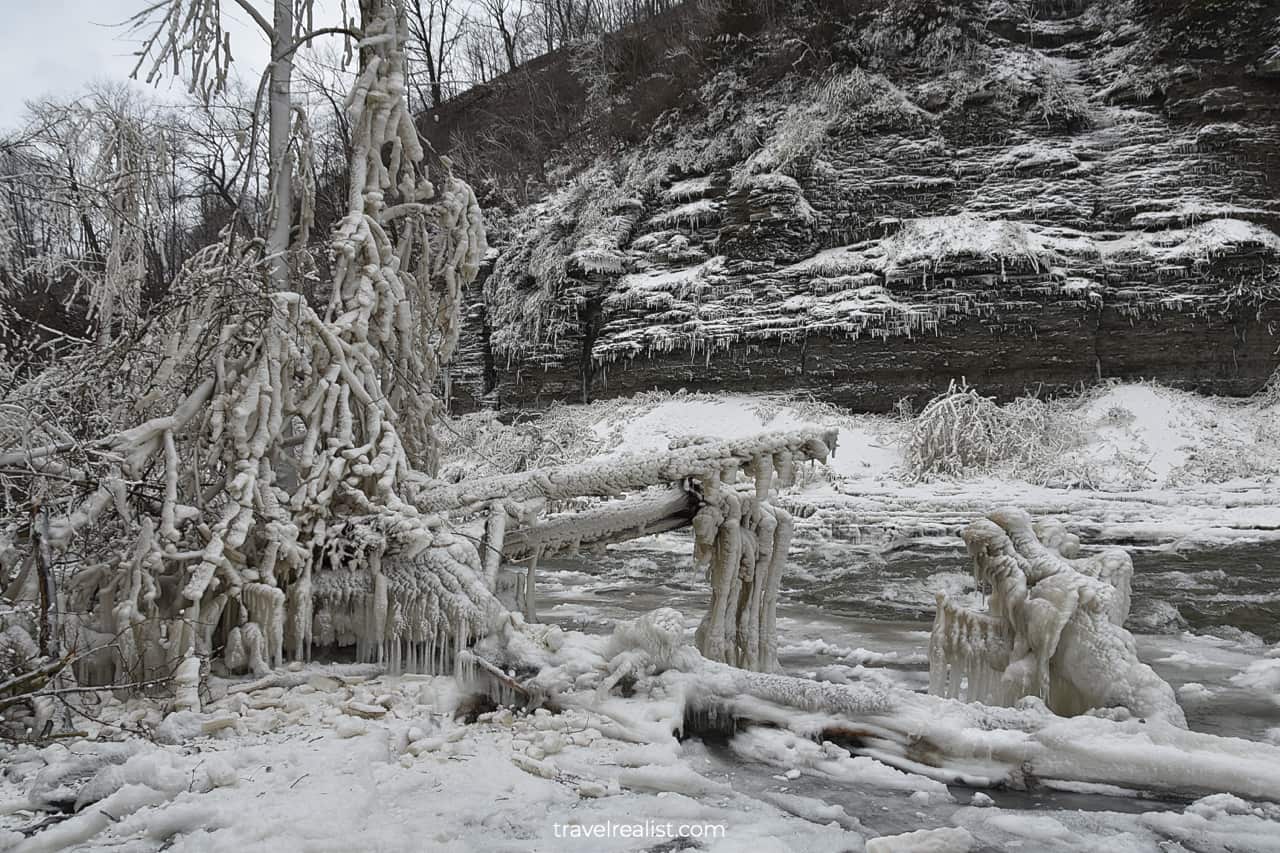
Where to Stay near Ithaca
Ithaca is an obvious choice for places to stay when visiting the waterfalls in and around this city. There are a lot of options thanks to its proximity to Cornell University.
But this location is a two-edged sword. Places to stay in Ithaca become sparse and expensive during the graduation weekend and campus visits.
On the bright side, there are a couple of unique places to stay right in the center of Ithaca. Take a look at Argos Inn – Ithaca’s Boutique Hotel for a stay in a historic building.
The Statler Hotel at Cornell University has the best views of the campus. And The Dorm Hotel recreates some of the on-campus experience but with private bathrooms.
But if a stay in Ithaca does not work out, look into towns around it. Watkins Glen, Corning, and Cortland are all viable options.
You will not go wrong with Staybridge Suites Corning, an IHG Hotel or Fairfield Inn & Suites by Marriott Cortland. These chain hotels provide an excellent and highly rated experience.
You would need to drive further away along Interstate Highways for other cities with places to stay. Check out Binghamton and Victor.
Buffalo and Scranton, Pennsylvania could also work out if your route brings you to Niagara Falls or NYC next. Both cities have a good number of places to stay.
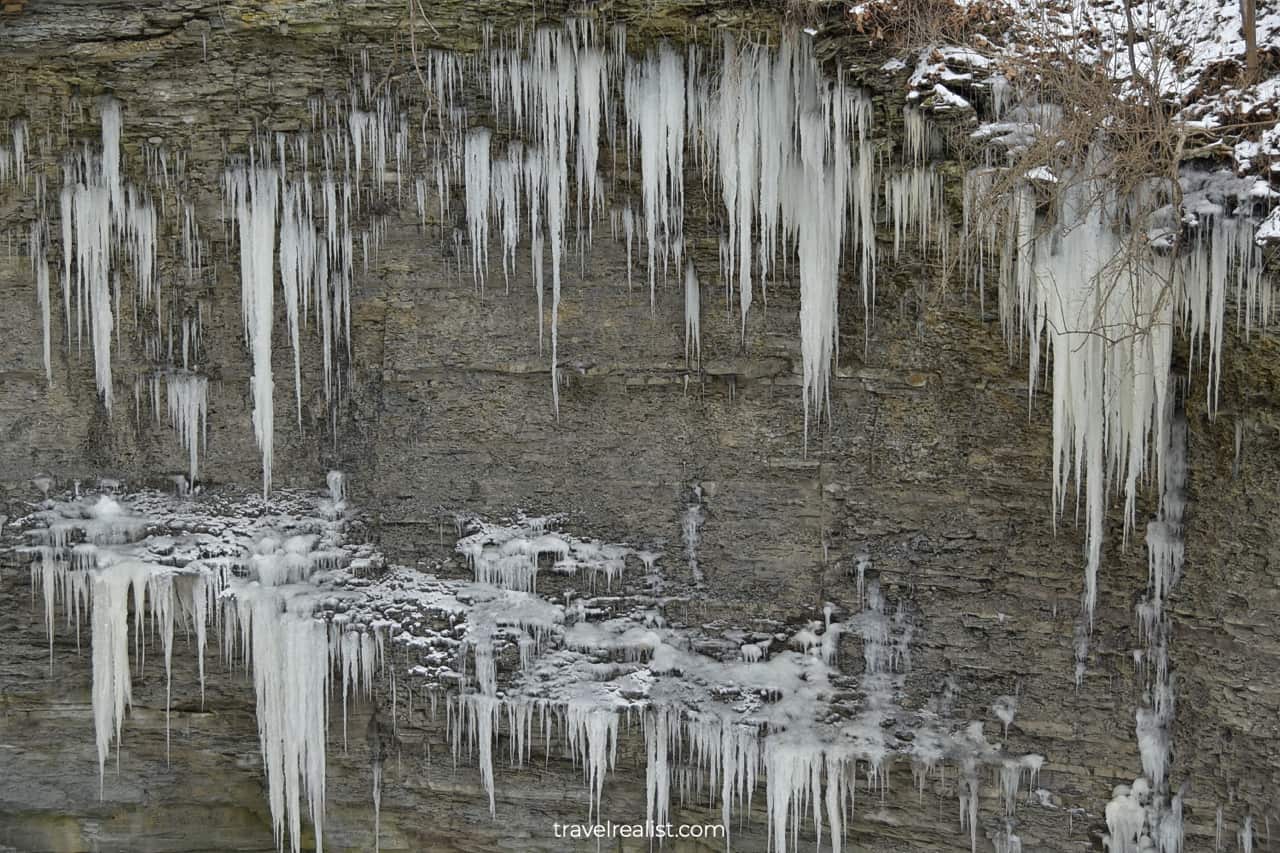
Entrance Requirements & Passes
Ithaca Waterfalls have different entrance requirements. Some are on campus of Cornell University. Others are within state parks and natural areas.
As a result, it could be helpful to have a one-stop solution for the main falls. This Ithaca Waterfalls Guide lists the opening hours and fees for the key waterfalls in the area.
Ithaca Falls Natural Area
Ithaca Falls is the easiest waterfall to visit in this town. You could see it around the clock for free. The parking lot is a little small and could get crowded.
- Opening hours: 24 hours a day, 365 days a year
- Nearest Parking: Ithaca Falls Parking Lot
- Fees: free
Waterfalls on Cornell University Campus
You would need to stop by Cornell University Campus to visit Horseshoe Falls, Rocky Falls, and Triphammer Falls.
There is an hourly fee to park there during weekdays. But the Toboggan Lodge Parking Lot and Forest Home Drive Parking Garage are free on the weekends.
- Opening hours: sunrise to sunset year round
- Nearest Parking: Toboggan Lodge Parking Lot
- Fees: $1.5 per hour, free on weekends at a few lots
Taughannock Falls State Park
Taughannock Falls are in the same name state park. It is quite easy to visit this waterfall. You just need to park at the Visitor Center and take a short trail to the viewpoint. The fees are not collected in the winter.
- Opening hours: sunrise to sunset year round
- Nearest Parking: Taughannock Falls Overlook Visitors Center
- Fees: $9 per car; collected from mid May to mid October
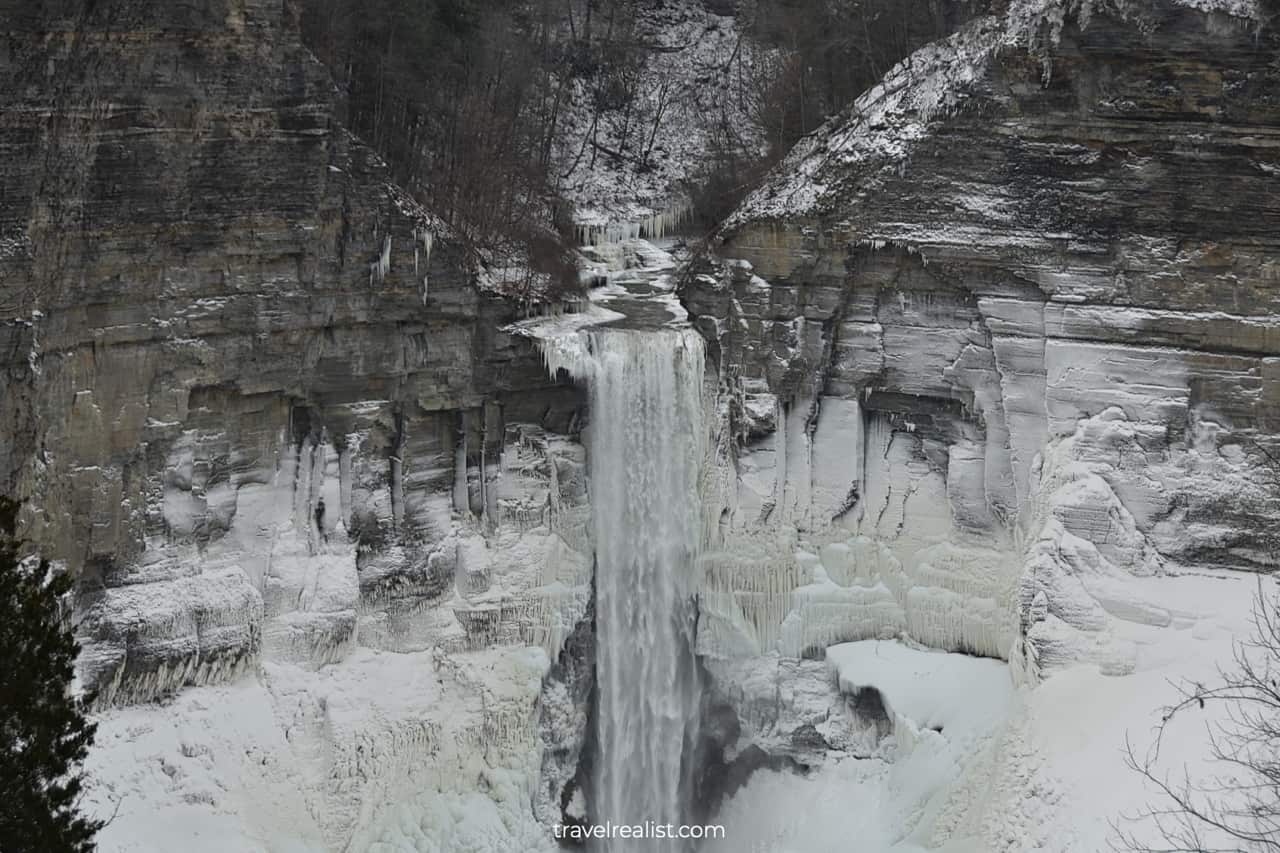
Takeaways: Ithaca Waterfalls
Ithaca is a beautiful destination at the head of Cayuga Lake in Upstate New York. This university town comes close to being a land of waterfalls in the United States.
Countless gorges, cascades, and waterfalls await visitors in Ithaca. You might want to visit the region during fall foliage when the trees show an amazing mix of colors.
But a winter visit to Ithaca should also not be out of question. You will enter a winter wonderland. Head to Ithaca Falls and Taughannock Falls or take a stroll on Cornell University campus.
A remote location of Ithaca is the only downside to a visit. Long drives from the major airports make it a poor choice for a long weekend.
It is better to stop by this region on a longer trip to Niagara Falls. This way, you will an option to choose a scenic drive instead of Interstate Highways.
Take a look at this Ithaca Waterfalls Video Guide. And visit the YouTube channel for the latest videos.
Frequently Asked Questions
There are 150 waterfalls in Ithaca, New York. Most of Ithaca waterfalls are on powerful mountain creeks and in narrow gorges.
Ithaca waterfalls have water year round. But the creeks and falls have the strongest flow during snowmelt in the spring. It takes place in late March or early April.
Waterfalls around Ithaca are more powerful after a heavy rainfall. Water levels are higher in September and October since it rains more often.
Summer is the time when Ithaca creeks have the lowest water levels. A few waterfalls are frozen in the winter.
Glacial activity millions of years ago is to thank for the number of waterfalls around Ithaca, New York. Glaciers formed gorges. Water from the surrounding mountains started to flow into these gorges. This process formed Finger Lakes, creeks, and waterfalls.
Fall and spring are the best seasons to visit Ithaca waterfalls. The falls will have the most water during the snowmelt around March or April. You could also catch the waterfalls during the spring blossom season.
Fall foliage is an amazing time to see Ithaca waterfalls. The falls will be powerful after more frequent rainfall. And vibrant fall colors are great addition to the powerful cascades.
Winter is an nice time to visit Ithaca waterfalls. Far fewer people come to the region during the colder months. But weather presents challenges to a winter visit. Here is how to overcome them:
– Wear sturdy hiking shoes and a waterproof jacket
– Give yourself more time to navigate slippery trails
– Know your limits: turn around before you injure yourself
Safe realist travels!


